HP dm1z: Taking Fusion on the Road
by Dustin Sklavos on February 21, 2011 7:00 PM ESTFusion-Powered: Application and Futuremark Performance
This was my first experience with AMD's E-350 APU, a chip which has been the subject of some contention around here. Jarred and I are basically in agreement where performance is concerned and the general positive impact the chip can have on the mobile market: it's where netbooks probably needed to be all along, and should hopefully supplant Intel's lackluster Atom platform. Where we differ is our enthusiasm for it: Jarred feels Brazos was long overdue and isn't the quantum leap we were hoping for and expecting, which is a perfectly fair assessment. We needed Brazos a while ago, and AMD is late to this party.
That said, I'm happy AMD finally did show up. You'll see the E-350 isn't a massive jump forward from Atom, but it's enough of one to make the netbooking experience finally enjoyable instead of being a sluggish chore. Subjectively speaking, in regular use I found the dm1z to be nearly as responsive as my Lenovo ThinkPad X100e which is equipped with AMD's first generation Congo platform (though upgraded to an Intel X25-V SSD instead of the still-respectable Western Digital Scorpio Black mechanical drive.) So how does the E-350 actually fare when compared to mobile kit?
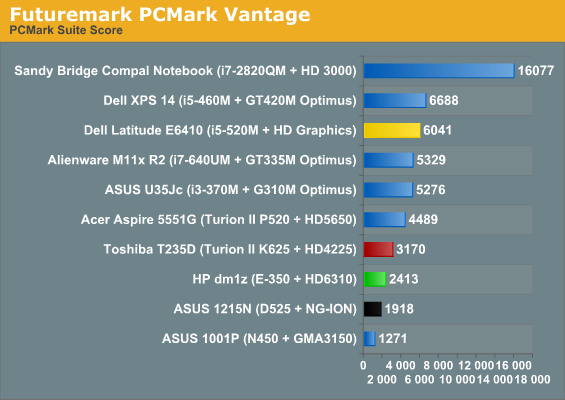
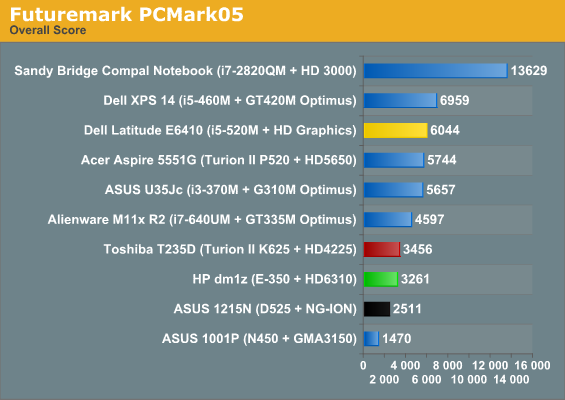
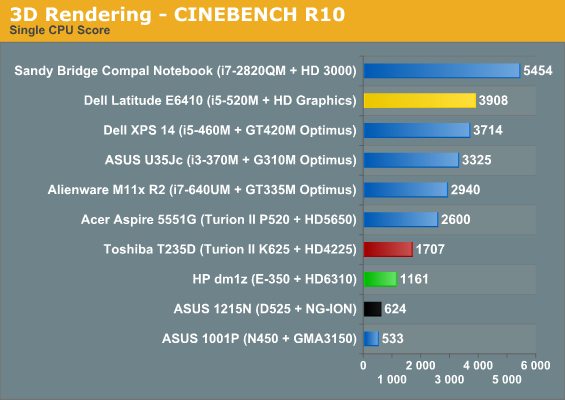
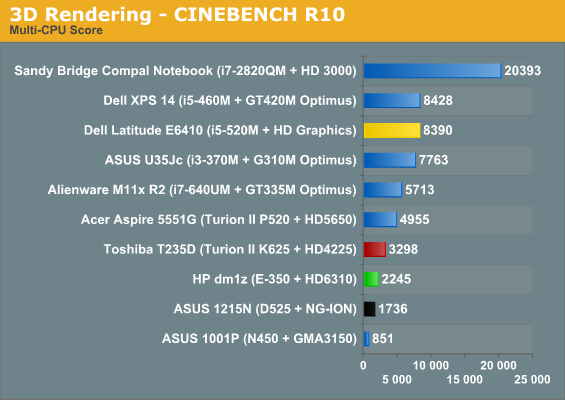
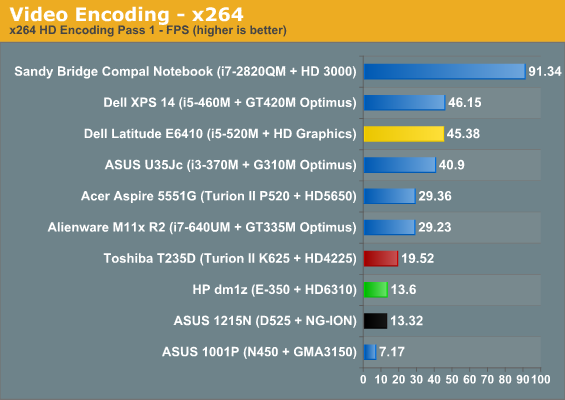
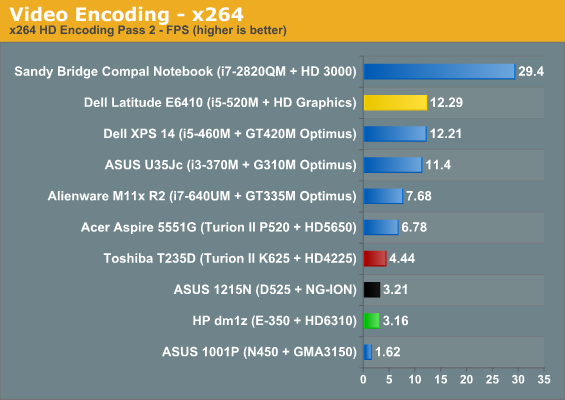
The first thing you'll notice is that while the E-350 generally cleans Atom's clock (the dual-core nettop D525 only comes out with a slight lead in the 2nd pass x264 encode), it's also generally about two-thirds as fast as the Nile platform's 1.5GHz Turion II K625. That's not too bad, but this is part of what Jarred's talking about, especially when you think about the Intel Core 2-based CULV kit that periodically kicks around the market (becoming stunningly rarefied). CULV hardware has also floated around the price point the dm1z is hitting shelves at, too, but it was fairly inconsistent. On the flipside, it does beat dual-core Atom equipped with NVIDIA's NG-ION, and this is a trend that's going to continue.
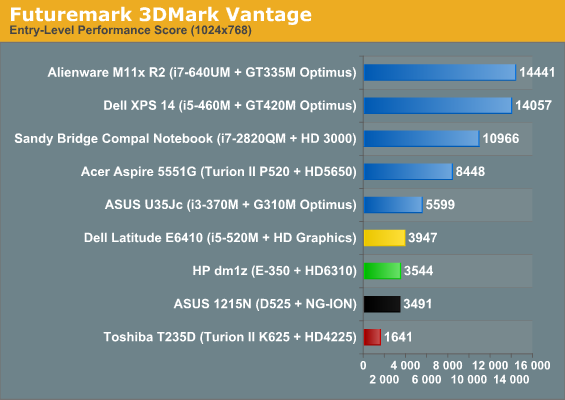
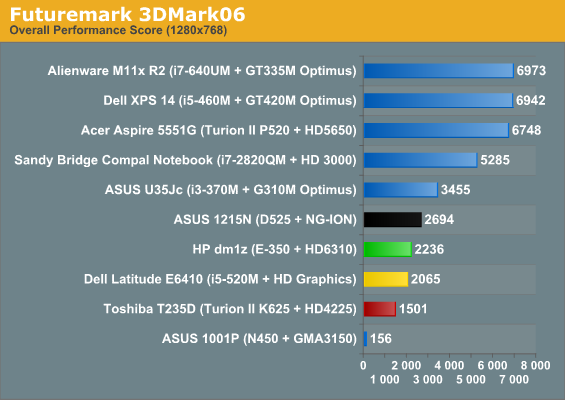
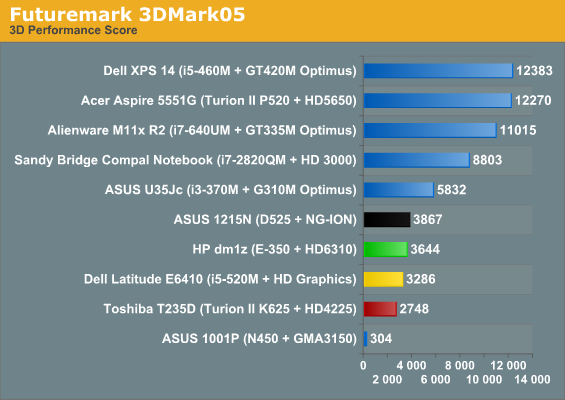
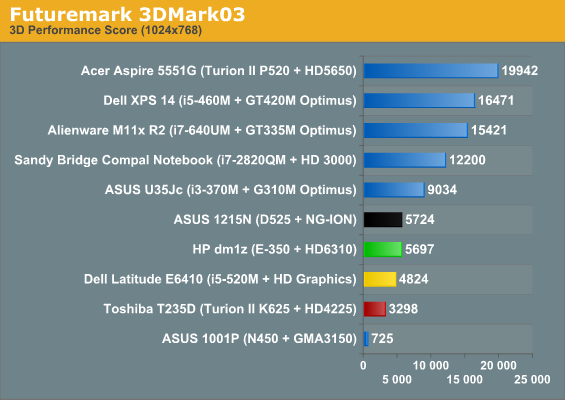
In 3DMark the E-350's integrated Radeon HD 6310 generally hangs out in the neighborhood of NG-ION, but it soundly beats Intel's last generation IGP (with better drivers and more stable performance to boot), and embarasses the Nile platform's Radeon HD 4225. That's not too surprising: in terms of raw GPU power the HD 6310 features twice the number of stream processors and a higher core clock.
If anything, the HD 6310 shows just how long in the tooth AMD's current IGP has really gotten: when it debuted as the 780G, it was a revelation, offering the best IGP performance bar none. The problem is that AMD just let it sit, offering new model numbers with no real performance increase outside of adding DirectX 10.1 support and bumping clocks slightly in some cases while serving us a warmed over Radeon HD 4550 in the form of the Radeon HD 5450 when they really should've just been integrating that hardware into their chipsets.
Ah well. With Brazos here now and Llano on the horizon, the era of AMD integrated graphics parts wearing out their welcomes should come to a close.










108 Comments
View All Comments
motomen2 - Tuesday, February 22, 2011 - link
I am also hoping for a review of the Thinkpad x120e! I am a previos owner of a Thinkpad and if it stacks up well against this one, I plan to buy it.Any news on this front?
JumpingJack - Monday, February 21, 2011 - link
I thought netbooks were considered to be screen sizes 10 inches or less, this is a bit large to be a 'netbook'.strikeback03 - Tuesday, February 22, 2011 - link
"Netbook" seems to be as much in relation to performance as size. There are 12 inch units that can't be considered anything but netbooks given that they use the same internals, just a little larger. So basically if you are looking at an 11.6" screen and Atom, it is a netbook. If it is an 11.6" screen and a C2D, not a netbook.mgl888 - Monday, February 21, 2011 - link
Thanks! Been waiting for this one to get reviewed!Can't wait for mine to arrive. I can tuck away my N270 Atom. w00t!
AmdInside - Monday, February 21, 2011 - link
At this point in time, I would only be interested in this netbook if I was a college student and couldn't afford a notebook or if I was just too poor to afford a notebook but needed a portable PC for some reason. The netbook craze has died since the iPad. I tried to like netbooks last year but either they were too expensive (and thus approaching notebook pricing) or just too limited. The iPad fill the void I had with a netbook. I just have no desire for this or any other netbook.mgl888 - Tuesday, February 22, 2011 - link
It really depends on what you use the device for.For me, an ultraportable (not an iPad) like this fills the gap between my desktop and my smartphone. There's no point for me to get a tablet because an Android tablet/iPad would simply be a repeat of everything I can already do with my phone on the go.
I would not choose a 14"+ notebook because it's just too bulky to carry around and the battery life is usually not as great. I've tried Atoms, but yes they are too slow for my taste. Fusion, on the other hand, fits my taste almost perfectly.
It would be nice to have better CPU performance and perhaps a slightly larger screen, but this is as close as it gets right now. Perhaps Llano will strike on target?
DanNeely - Monday, February 21, 2011 - link
The first half of the pricing link "Starting at $4" goes to cyberpowerpc, not hp.JarredWalton - Tuesday, February 22, 2011 - link
Thanks, fixed... and the HP shopping link works properly as well now.Aone - Monday, February 21, 2011 - link
I would appreciate if the auther have used the proper terms.Netbook, as it was introduced by Intel, is 10" box. HP DM1z has 11.6 screen and that is the big difference.
If AT wants to compare AMD's offering with Intel's one in proper manner i.e. in netbook space he should take C-50 but not E-350. Do it and you feel the big difference!
cyrusfox - Tuesday, February 22, 2011 - link
Markets change and so do terms, Intel didn't create the term by the way. Been around before atom or Asus. They gained the most recognition through the intriguing asus eee 700 and its successors.See wiki excerpts below:
http://en.wikipedia.org/wiki/Netbook
"The generic use of the term "netbook", however, began in 2007 when Asus unveiled the ASUS Eee PC. Originally designed for emerging markets, the 23 × 17 cm (9.1 × 6.7 in) device weighed about 0.9 kg (2 lb) and featured a 7 in (18 cm) display, a keyboard approximately 85% the size of a normal keyboard, a solid-state drive and a custom version of Linux with a simplified user interface geared towards netbook use."
"In the short period since their appearance, netbooks have grown in size and features, now converging with new smaller, lighter notebooks. By August 2009, when comparing a Dell netbook to a Dell notebook, CNET called netbooks "nothing more than smaller, cheaper notebooks," noting, "the specs are so similar that the average shopper would likely be confused as to why one is better than the other," and "the only conclusion is that there really is no distinction between the devices.""
So you can be like engadget and others and call it a notbook if you choose, everything a netbook should be(peppy/versatile with the battery life and size of a netbook).